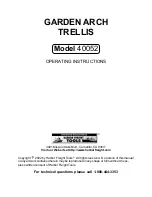
not possible, ART may be used to measure electrode resistance.
The instrument terminals should be connected to the system under test through isolation switches that are rated to
handle the likely maximum fault voltages and currents that could be encountered at the installation. The isolation
switch must be open whilst any personal contact is made with the remote test stakes, or the connecting leads, e.g.
when changing their position.
The instrument terminals should be connected to the system under test through fuses that are rated to handle the
likely maximum fault voltages and currents that could be encountered at the installation.
G
BATTERY INSTALLATION
Warning: Whenever battery cells are being fitted or replaced, there should be no connections to the instrument
terminals and the instrument should be switched off.
Warning: To avoid damage by leaking electrolyte or deep discharge, do not leave cells fitted in an instrument
which will remain unused for extended periods of time.
Warning: Incorrect battery cell polarity can cause electrolyte leakage, resulting in damage to the instrument. If the
battery condition indicator does not show a full charge when battery cells are new, a cell may be reversed.
DET4TR2 and DET4TCR2 ONLY Warning: Only use the cells recommended by Megger, part number 1000-530.
G
BATTERY CHARGING (DET4TR2 and DET4TCR2 ONLY)
Warning: Whenever battery cells are being recharged, there should be no connections to the instrument terminals
and the instrument should be switched off.
Warning: Do not attempt to recharge non-rechargeable (dry) cells in the DET4TR2 and DET4TCR2. Doing so will
result in instrument damage and may cause personal injury.
Warning: Only use the charging equipment provided by Megger for use with this instrument.






































